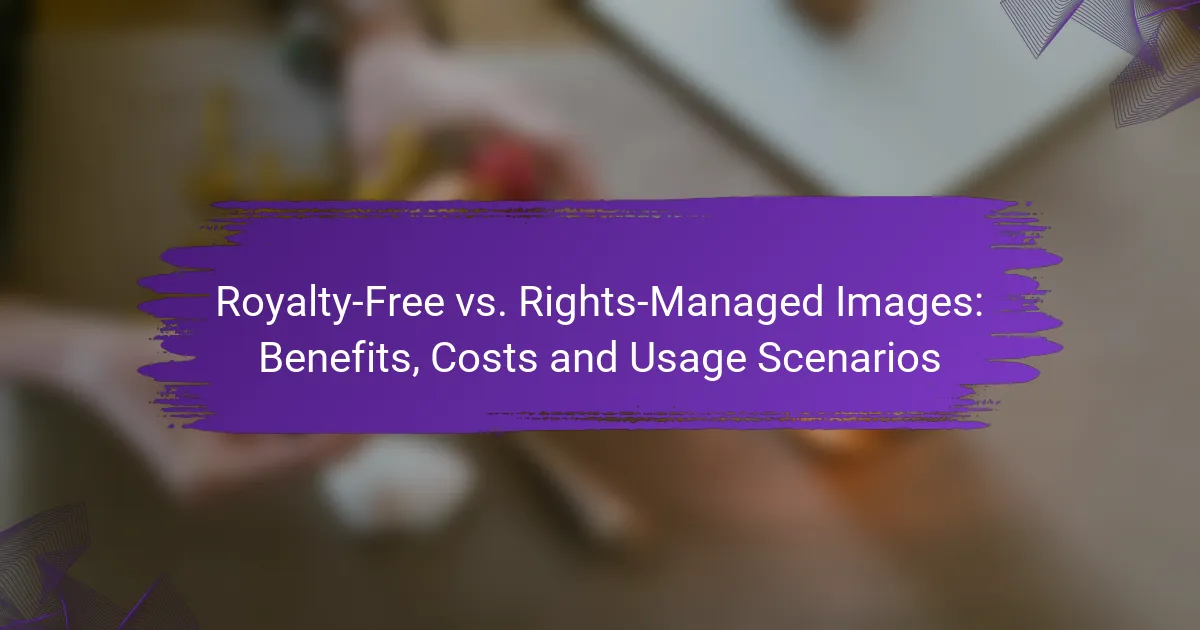When choosing between royalty-free and rights-managed images, it’s essential to understand the benefits, costs, and usage scenarios associated with each option. Royalty-free images offer an affordable way to access a diverse range of visuals with fewer restrictions, while rights-managed images provide exclusivity and tailored licensing for specific projects. Evaluating your budget and project needs will help determine the best choice for your visual content requirements.
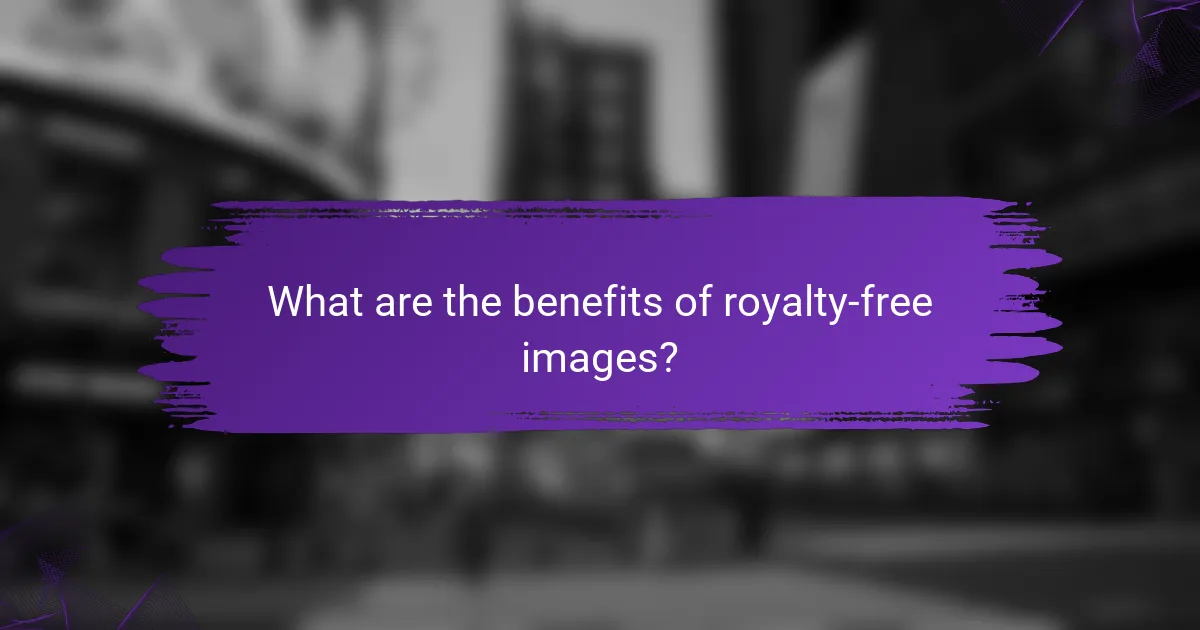
What are the benefits of royalty-free images?
Royalty-free images provide a cost-effective solution for obtaining high-quality visuals without the complexities of traditional licensing. Users can access a wide range of images for various projects, often with fewer restrictions on usage.
Cost-effective for budget-conscious projects
Royalty-free images are often available for a one-time fee or through subscription services, making them accessible for projects with limited budgets. This pricing model allows individuals and small businesses to acquire professional images without incurring high costs associated with rights-managed options.
For example, a subscription to a stock photo service may cost between $10 to $50 per month, allowing users to download multiple images, whereas rights-managed images can range from hundreds to thousands of dollars depending on usage and exclusivity.
Flexible usage across multiple platforms
Royalty-free images can typically be used across various platforms, including websites, social media, and print materials, without needing additional permissions. This flexibility is particularly beneficial for marketers and content creators who require consistent visuals for different formats.
However, it’s essential to review the specific licensing terms, as some royalty-free images may have restrictions on resale or use in merchandise. Always check the license agreement to ensure compliance with usage rights.
No need for ongoing licensing fees
With royalty-free images, once you purchase the image, there are no ongoing licensing fees or royalties to pay for continued use. This contrasts with rights-managed images, which often require additional payments based on usage duration or distribution scale.
This one-time payment structure simplifies budgeting for projects, allowing creators to allocate funds more effectively. It’s advisable to keep records of purchased images and their licenses to avoid potential disputes over usage rights in the future.
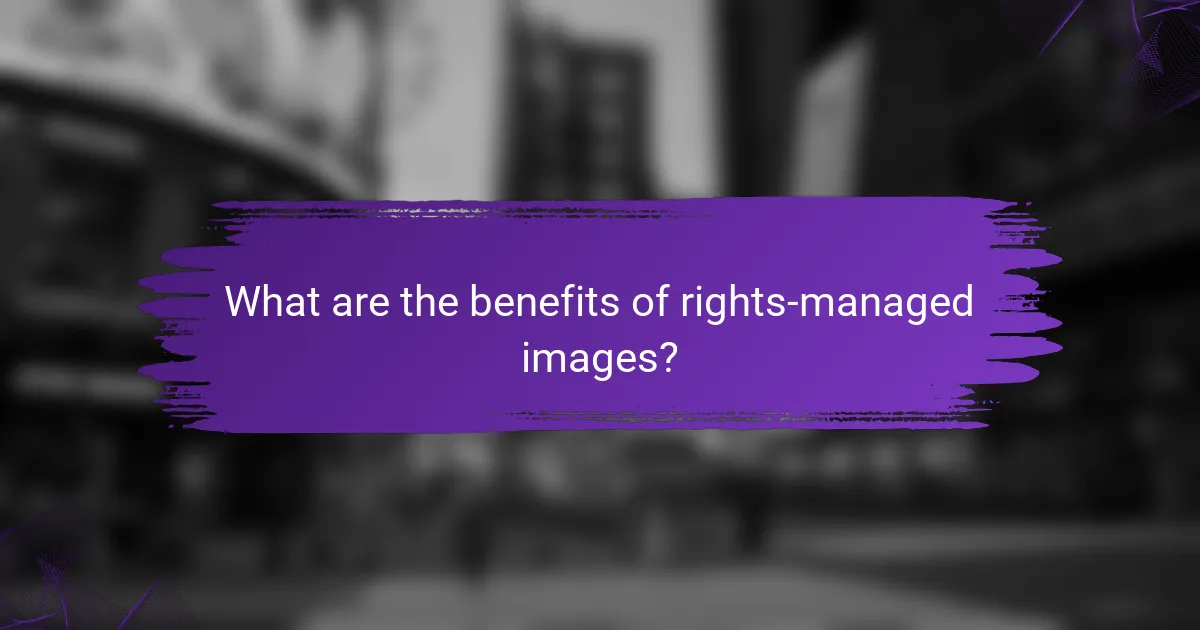
What are the benefits of rights-managed images?
Rights-managed images offer distinct advantages, particularly in terms of exclusivity and quality. These images are licensed for specific uses, ensuring that the buyer has unique access to the content for their projects.
Exclusive usage rights for specific projects
Rights-managed images provide exclusive usage rights tailored to particular projects, which means that once you purchase a license, no one else can use that same image for the same purpose. This exclusivity is crucial for brands that want to maintain a unique identity and avoid competition in visual representation.
For example, a marketing campaign for a luxury product may require exclusive imagery to convey a specific message. By opting for rights-managed images, companies can ensure that their visuals remain distinctive and impactful.
Higher quality and unique content
Rights-managed images often come from professional photographers and agencies, resulting in higher quality and more unique content compared to royalty-free options. These images are typically curated for specific themes or styles, making them more suitable for high-end projects.
Investing in rights-managed images can enhance the overall aesthetic of a project, particularly in industries like fashion, real estate, or advertising, where visual appeal is paramount. The uniqueness of these images can also help in storytelling and brand differentiation.
Clear licensing terms and usage restrictions
With rights-managed images, licensing terms are clearly defined, outlining how and where the image can be used. This clarity helps avoid potential legal issues related to copyright infringement, as users know exactly what is permitted.
For instance, a rights-managed license may specify that an image can only be used in print media for a limited time or within a specific geographical area. Understanding these restrictions is essential for compliance and effective planning in marketing strategies.
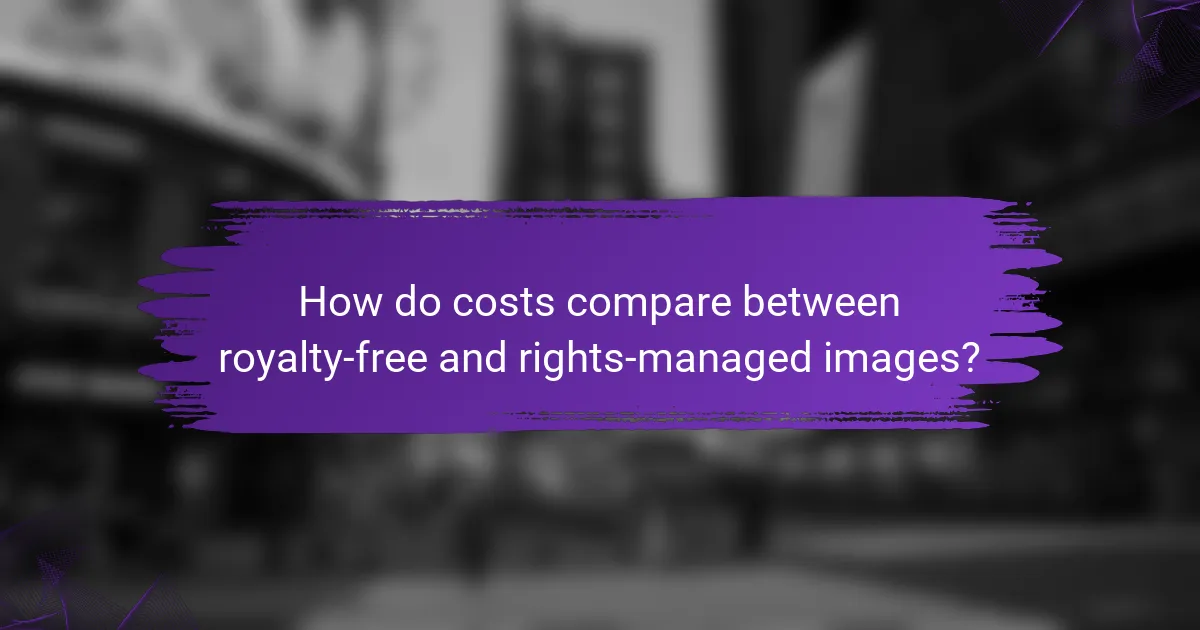
How do costs compare between royalty-free and rights-managed images?
The costs of royalty-free and rights-managed images differ significantly, impacting your budget and project planning. Royalty-free images generally have lower upfront costs, while rights-managed images can lead to higher fees based on specific usage scenarios.
Royalty-free images typically have lower upfront costs
Royalty-free images are often available for a one-time fee, allowing users to download and use the images without ongoing royalties. Prices can range from a few dollars to around a hundred, depending on the image quality and source. This model is particularly appealing for small businesses or individuals with limited budgets.
Many stock photo websites offer subscription plans that further reduce costs, enabling users to access a library of images for a monthly fee. This can be a cost-effective solution for projects requiring multiple images.
Rights-managed images can incur higher fees based on usage
Rights-managed images typically involve higher fees that vary based on factors like the intended use, distribution size, and duration of use. For example, a single-use license for a magazine cover may cost significantly more than a web-only license. This pricing structure ensures that the creator is compensated fairly for the image’s specific application.
Users should carefully assess their needs before purchasing rights-managed images, as costs can escalate if the usage parameters change. Always check the licensing agreement to avoid unexpected fees.
Long-term costs may vary based on project needs
When considering long-term costs, royalty-free images may be more economical for ongoing projects, as they allow unlimited use after the initial purchase. This is ideal for businesses that require consistent branding or frequent updates to their marketing materials.
In contrast, rights-managed images might be more suitable for high-profile projects where exclusivity is essential. However, if the project evolves or requires additional usage, costs can accumulate quickly. Evaluating the scope and future needs of your project will help determine the most cost-effective option.
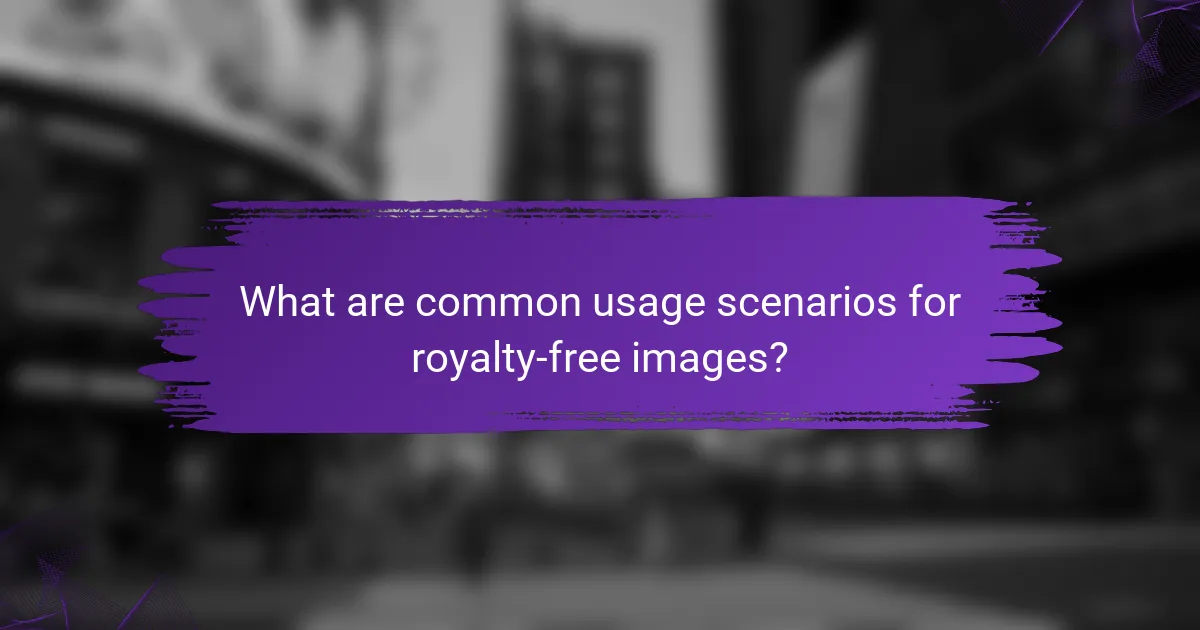
What are common usage scenarios for royalty-free images?
Royalty-free images are commonly used in various contexts where businesses and individuals need visual content without the burden of ongoing fees. These scenarios include marketing, content creation, and small business branding, allowing for flexibility and cost savings.
Social media marketing campaigns
In social media marketing, royalty-free images can enhance posts, making them more engaging and visually appealing. Brands often use these images for promotional graphics, advertisements, or to accompany posts that drive user interaction.
When selecting images, consider the platform’s audience and preferred styles. For instance, vibrant and dynamic visuals may work well on Instagram, while more professional images might be suited for LinkedIn. Ensure the images align with your brand’s voice and message.
Blog posts and website content
Royalty-free images are ideal for enriching blog posts and website content, as they help illustrate points and break up text. Using relevant visuals can improve reader retention and comprehension, making your content more effective.
When choosing images, ensure they are directly related to the topic at hand. Aim for high-quality visuals that complement your writing. Additionally, check the licensing terms to confirm that the images can be used for your specific purpose, such as commercial use or modifications.
Stock photography for small businesses
Small businesses often utilize royalty-free images for marketing materials, websites, and promotional items. This approach allows them to access professional-quality visuals without the high costs associated with hiring photographers.
Consider creating a library of images that reflect your brand identity. This can include product shots, team photos, or lifestyle images that resonate with your target audience. Always verify the licensing agreements to avoid potential legal issues, especially if you plan to use the images in advertisements or merchandise.

What are common usage scenarios for rights-managed images?
Rights-managed images are typically used in situations where exclusivity and specific usage rights are crucial. These scenarios often involve high-stakes projects where the image’s licensing directly impacts the brand’s reputation and marketing effectiveness.
High-profile advertising campaigns
In high-profile advertising campaigns, brands often opt for rights-managed images to ensure they have exclusive rights to the visuals used. This exclusivity can enhance the campaign’s impact and prevent competitors from using the same imagery, which is especially important for luxury brands or major product launches.
When selecting rights-managed images for advertising, consider the duration of the campaign and the specific media channels involved. Costs can vary significantly based on these factors, often ranging from hundreds to thousands of dollars depending on the image’s popularity and the intended reach.
Editorial publications and magazines
Editorial publications and magazines frequently utilize rights-managed images to maintain high standards of quality and originality. These images often accompany articles and features, providing a visual narrative that aligns with the publication’s brand identity.
When using rights-managed images in editorial contexts, it’s essential to understand the licensing terms, including geographic restrictions and duration of use. This ensures compliance and avoids potential legal issues, as misuse can lead to costly penalties.
Corporate branding and presentations
For corporate branding and presentations, rights-managed images can reinforce a company’s message and values. Utilizing unique visuals helps differentiate a brand in competitive markets, making it memorable to clients and stakeholders.
When selecting images for corporate use, consider the specific audience and context of the presentation. Investing in high-quality, rights-managed visuals can enhance professionalism and credibility, often justifying the higher costs associated with these images.

How to choose between royalty-free and rights-managed images?
Choosing between royalty-free and rights-managed images depends on your budget, the exclusivity you need, and how you plan to use the images. Understanding these factors will help you make an informed decision that aligns with your project’s goals.
Assess project budget and scope
Your budget plays a crucial role in deciding between royalty-free and rights-managed images. Royalty-free images typically have a lower upfront cost, often available for a one-time fee, making them suitable for projects with limited budgets. In contrast, rights-managed images can be more expensive, as they are priced based on factors like usage duration, distribution, and exclusivity.
Consider the scope of your project when evaluating costs. If you need multiple images for a large campaign, royalty-free options may be more economical. However, for high-profile projects where image quality and exclusivity are paramount, investing in rights-managed images might be justified.
Consider the desired exclusivity of images
Exclusivity is a key factor when selecting images. Rights-managed images offer a higher level of exclusivity, as they are licensed for specific uses and often limit the number of times an image can be used by others. This can be essential for brands looking to maintain a unique visual identity.
On the other hand, royalty-free images are available to anyone who purchases them, which can lead to the same image being used by multiple entities. If your project requires a distinctive look, rights-managed images may be the better choice, despite the higher cost.
Evaluate the intended usage and distribution
Understanding how you plan to use and distribute the images is vital in your decision-making process. Rights-managed images typically come with restrictions on usage, such as geographic limitations or specific media types, which can affect your distribution strategy.
In contrast, royalty-free images generally allow for broader usage across various platforms without additional fees, making them ideal for online content, social media, or smaller campaigns. Assess your distribution needs carefully to ensure that the image licensing aligns with your intended use.
